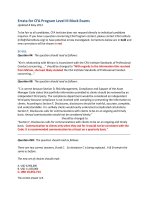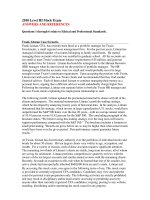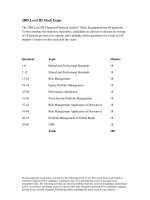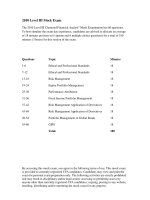2013 level III sample exam version 1
Bạn đang xem bản rút gọn của tài liệu. Xem và tải ngay bản đầy đủ của tài liệu tại đây (396 KB, 17 trang )
2013 Level III Sample Exam Version 1
Jacaranda Asset Management Case Scenario
Most financial services regulatory bodies in East Africa are moving toward risk-based
supervision models. Miriam Bukenya, CFA, is the head of compliance at Jacaranda
Asset Management, a manager of both retail and institutional portfolios. She is
currently revising the company's compliance policies to address risk in all areas of the
business and is checking different aspects of the firm to ensure that it will be able to
meet new risk-based supervision regulations when they become effective in six
months' time. The firm recently adopted the CFA Institute Code of Ethics and
Standards of Professional Conduct as its own Code and Standards.
While reviewing Jacaranda's compliance manual, Bukenya realizes it needs a few
changes to comply with the new risk-based regulations. To ensure she uses best
practice, she consults with Luc Remmy, CFA, the head of compliance at her former
employer, Mercury Advisory Services. Remmy, who now runs an independent
consulting firm, e-mails Bukenya the compliance manual he uses for his own firm.
While reviewing the compliance manual, Bukenya notices that many sections look
familiar. She finds a statement in the document indicating that it is for the "sole use of
Mercury Advisory Services." When questioned, Remmy states that he used only the
table of contents of Mercury's document and none of the other content in the
document to develop his compliance manual.
Bukenya looks at the marketing materials Jacaranda uses to communicate to existing
and prospective clients to ensure that everything mentioned in the material is factual
and complies with the CFA Standards of Professional Conduct. The following
statements are examined:
Statement 1: Jacaranda looks for investments offering intrinsic value through a topdown approach including a review of forecasts of economic and
industry performance. We evaluate historical and projected company
financials, perform extensive financial ratio analysis, conduct
management interviews, and determine target prices using a variety of
valuation models.
Statement 2: Jacaranda may, at times, hire outside advisers to manage real estate
holdings on behalf of clients. These advisers have the necessary
expertise to manage property assets.
Statement 3: Jacaranda has four CFA charterholders among its senior management.
Their participation in the CFA examination program has enhanced their
investment management skills. All of these managers passed the three
exams in the shortest time possible.
The new risk-based regulations also require accurate and complete performance
presentations, with all discretionary accounts included in at least one composite.
Bukenya believes Jacaranda's performance presentation policy meets these new
requirements as well as the CFA Institute Code of Ethics and Standards of
Professional Conduct since Jacaranda's single composite includes all current and
terminated client accounts and presentations include this statement: "Detailed
information regarding the performance presentation is available upon request." While
Jacaranda does not currently comply with GIPS Standards, she encourages the firm to
do so within the next few years.
Bukenya then reviews Jacaranda's record-keeping policy. Currently, the policy
requires retention of hard copies of all supporting documentation for investment
recommendations and decisions made during the last five years. This policy meets the
new risk-based regulations. Client meeting minutes and communication logs are kept
electronically and backed up on a remote server. Fund managers and research analysts
are responsible for maintaining their own personal notes and research models. This
policy also applies to Jacaranda's independent research contractor, Mathew Ochieng,
who (for security reasons) does not have access to the company's server. Ochieng,
who undertakes research only for Jacaranda, sends his research reports to the Head of
Research, who then archives the electronic copies.
While reviewing Jacaranda's counterparty risk policy, Bukenya discovers that trader
Jackson Gatera recently convinced the back office to override controls designed to
prevent overexposure to specific stockbrokers. This was in violation of company
rules. The rules state that if the trading allocation to a specific broker is breached,
trading through that broker must be suspended until the exposure drops to within the
exposure limits. The Counterparty Risk Committee predetermines these limits.
The new risk-based regulations also require companies to gather client information as
part of "Know Your Client" and anti-money-laundering processes. Bukenya creates a
confidentiality policy restricting access to existing and prospective client information.
The information is available only to personnel who are authorized by the existing or
prospective client. The one exception is if the client or prospective client is thought to
be conducting illegal activities. In this circumstance, the information can be released
without authorization if the information is demanded through a court order or other
legal requirement.
1. Which of the following CFA Institute Standards of Professional Conduct did
Remmy
least
likely
violate?
A.
B.
C.
Responsibilities
of
Loyalty
Misrepresentation
Supervisors
2. Which marketing statement should Bukenya most likely revise to conform to
the CFA Institute Code of Ethics and Standards of Professional Conduct?
A.
B.
C.
Statement
Statement
Statement
1
2
3
3. Does Jacaranda's performance presentation policy most likely meet
recommended procedures for complying with CFA Institute Code of Ethics
and
Standards
of
Professional
Conduct?
A.
Yes.
B.
No,
because
of
the
structure
of
the
composite.
C. No, because it is not in compliance with GIPS standards.
4. Jacaranda's record-keeping policy is most likely in violation of CFA Institute
Standard
V
(C)
Record
Retention
regarding
the:
A.
B.
C.
keeping
retention
retention
time
of
hard
and
electronic
of
personal
notes
and
research
frame.
copies.
models.
5. In response to Gatera's actions, Bukenya should least likely recommend
which of the following actions to prevent violations of the CFA Institute
Code
of
Ethics
and
Standards
of
Professional
Conduct?
A.
B.
C.
Increase
Report
Investigate
supervision
Gatera
to
of
CFA
further.
Gatera.
Institute.
6. Does Bukenya's confidentiality policy most likely violate CFA Institute
Standard
III
(E)
Preservation
of
Confidentiality?
A.
B.
C.
Yes,
Yes,
regarding
regarding
type
client
of
No.
status.
information.
Ptolemy Foundation Case Scenario
The Ptolemy Foundation was established to provide financial assistance for research
and education in the field of astronomy. Tom Fiske, the foundation's chief investment
officer, and his staff of three analysts employ a top-down process that begins with an
economic forecast, assignment of asset class weights, and select ion of appropriate
index funds. The team meets once a week to discuss a variety of topics ranging from
economic modeling to economic outlook, portfolio performance, and investment
opportunities, including those in emerging markets.
At the start of the meeting, Fiske ash the analyst s, Len Tuoc, Kim Spenser, and Pier
Poulsen, to describe and justify their different approaches to economic forecasting.
They reply:
Tuoc:
"I prefer econometric modeling. Robust models built with detailed
regression analysis can help predict recessions well because the
established relationships among the variables seldom change."
Spenser:
"I like the economic indicators approach. For example, the composite of
leading economic indicators is based upon an analysis of its forecasting
usefulness in past cycles. They are intuitive, simple to construct, require
only a limited number of variables, and third-party versions are also
available."
Poulsen:
"The checklist approach is my choice. This straightforward approach
considers the widest range of data. Using simple statistical methods like
time-series analysis, an analyst can quickly assess which measures are
extreme. This approach relies less on subjectivity and is less timeconsuming."
The team then discusses what the long-term growth path for U.S. GDP should be in
the aftermath of exogenous shocks due to the financial crises that began in 2008. They
examine several reports from outside sources and develop a consensus view of 10year annual growth expectations for the items in Exhibit 1.
After a review of the portfolio and his discussion with the investment team, Fiske
determines a need to increase U.S. large-cap equities. He prefers to forecast the
average annual return for U.S. large-cap equities over the next 10 years using the
Grinold-Kroner model and the data in Exhibit 2.
The analysts think that adding to U.S. Treasuries would fit portfolio objectives but
they are concerned that the Federal Reserve is likely to raise the feel funds rate soon.
They assemble the data in Exhibit 3 in order to use the Taylor rule to help predict the
Fed's next move with respect to interest rates.
To assess the attractiveness of emerging market equities, Fiske suggests that they use
the data in Exhibit 4 and determine the expected return of small-cap emerging market
equities using the Singer-Terhaar approach.
Finally, upon examining the data pertaining to the European equity markets, the
investment team believes there are attractive investment opportunities in selected
countries. Specifically, they compare the recent economic data with long-term average
trends in three different countries (Exhibit 5).
7. Regarding the approaches to economic forecasting, the statement by which
analyst
is
most
accurate?
A.
B.
C.
Tuoc
Spenser
Poulsen
8. Using the data in Exhibit 1 and the simplest approach to analyze aggregate
trend growth for U.S. GDP, the most likely estimate for the 10-year annual
GDP
growth
(in
%)
is:
A.
B.
3.0.
3.5.
C.
3.6.
9. Using the data in Exhibit 2 and Fiske's preferred approach, the estimated
expected annual return (in %) for U.S. large-cap equities over the next 10
years
is
closest
to:
A.
B.
C.
5.6.
7.6.
8.4.
10. Using the data in Exhibit 3 and the investment team's approach to predict the
Fed's next move, the new fed funds rate (in %) will most likely be:
A.
B.
C.
2.1.
2.6.
2.9.
11. Using the data in Exhibit 4 and Fiske's suggested approach, the forecast of
the expected return (in %) for small-cap emerging market equities is closest
to:
A.
B.
C. 9.85.
8.94.
9.54.
12. Among the three countries examined by the investment team, which is in the
most attractive phase of the business cycle for equity returns?
A.
B.
C.
Spain
Ireland
Hungary
Sophia Doulton Case Scenario
Sophia Doulton, CFA, owns Doulton Investments, LLC, an asset management firm.
She is preparing for a meeting with Jorge Thompson, a new client. At an earlier
meeting, Thompson provided information about his current portfolio holdings and the
investment policy statement (IPS) created for him by his previous investment adviser.
Thompson has stated that he is generally happy with the IPS but left the previous
adviser because of high fees and poor investment returns. He asked Doulton to review
the JPS and let him know if changes are warranted.
Thompson's current IPS includes the strategic asset allocation shown in Exhibit 1.
Doulton's long-term and short-term return expectations for each asset class are
included.
The IPS allows for asset allocations that diverge from its strategic allocations based
on the following rules and reasoning:
Rule 1:
The portfolio should always overweight emerging market equities because
most long-term forecasts show high expected returns for this asset class
relative to the others.
Rule 2:
The asset manager may make tactical allocations to asset classes not
included in the strategic asset allocation because the portfolio manager
has discretion to pursue excess returns wherever they are available.
Rule 3:
The total allocation to bonds (U.S. and non-U.S.) should never be less
than 35% because Thompson views the bond allocation as being his
retirement portfolio and does not want too much risk taken with that
money.
Doulton is considering two additional asset classes that could be added to Thompson's
strategic asset allocation. Information about the current portfolio and these two asset
classes is found in Exhibit 2.
Thompson's previous investment adviser used a single-period mean-variance
approach to determine his optimal strategic asset allocation. Doulton is concerned
about this because most of the portfolio's returns are taxable and are subject to a
variety of marginal rates, depending on the type and length of the investment.
Furthermore, Thompson's income over the next 10 years will likely result in
substantial additional contributions to the portfolio. Doulton plans to recommend a
different approach to optimization for Thompson.
Thompson does not currently hedge any of the currency risk in his strategic portfolio,
which contains a 40% foreign asset exposure. He asks Doulton to estimate the impact
of currency risk on that part of his portfolio. Doulton estimates the standard deviation
of Thompson's foreign assets in local currency terms to be 22%, the standard
deviation of the exchange rate is 12%, and the correlation between foreign asset
returns in local currency and exchange rate movements is 0.4.
13.
Based on Doulton's return expectations provided in Exhibit 1, she would
most likely implement which of these tactical asset allocation adjustments
relative
to
the
strategic
asset
allocations?
14. Which of the asset allocation rules in Thompson's IPS is least appropriate?
A.
B.
C.
Rule
Rule
Rule
1
2
3
15. The tactical asset allocation rules in Thompson's IPS suggest which of these
behavioral
influences?
A.
B.
C.
Fear
of
regret
aversion
accounting
Los
Mental
16. Using the information provided in Exhibits 1 and 2, Doulton should most
likely recommend adding which new asset class(es) to Thompson's strategic
asset
allocation?
A.
B.
C.
New
New
Both
asset
asset
new
class
class
asset
#1
#2
classes
17. Which approach to optimization would be most appropriate for Doulton to
recommend
to
Thompson?
A.
Black-Litterman
B.
C.
Monte
Resampled
Carlo
efficient
simulation
frontier
18. The contribution of currency risk to the risk of Thompson's foreign assets is
closest
to:
A.
B.
C.
1.44%.
3.06%.
6.97%.
Rioja Case Scenario
Andres Rioja is the treasurer of Empresas Crianza. His duties have recently been
expanded to include oversight of the firm's pension fund. Given his limited experience
in overseeing investments, he is relying on an outside consultant. Rioja prepares a
number of questions for his first meeting with the consultant, Manolo Priorat of
Consulta Jerez.
Priorat starts the meeting by summarizing the status of the defined-benefit pension
plan to Rioja and makes the following statement: "The pension liability has duration
of 14 and a present value of 54 billion. The liabilities are discounted using the spot
rate on high-quality long-term corporate bonds. The existing asset portfolio covers
87.5% of these liabilities and is invested entirely in fixed-income assets. The plan
assets have fallen short of the pension liabilities over the past five years because their
durations are not properly matched. I am concerned that Crianza has selected the
wrong benchmark for the pension plan. The current benchmark is a weighted average
of the benchmarks for the various strategies employed in the investment of pension
assets. I believe the appropriate benchmark should be the liability itself."
Priorat and Rioja review the fixed-income funds in which the pension assets are
currently invested. Portfolio managers have been given the mandate to meet or exceed
their respective benchmarks based on their investment styles. Details of the various
portfolios are provided in Exhibit 1.
Rioja updates Priorat on Crianza's current plans for the pension plan. Rioja states,
"Crianza will make a $500 million contribution to fully fund the plan and invest the
funds in Treasury STRIPs. In addition, we would like to completely reallocate pension
investments away from the fund that presents the greatest contingent claim risk and
into the Long Corporate Bond Fund."
Rioja then asks Priorat, "I would like to understand the risk profile of each index
benchmark we have assigned to the portfolio managers. What measures are available
to do this?" Priorat responds, "There are several key measures that come to mind.
Effective duration measures the sensitivity of the index's price to a relatively small
parallel shift in interest rates. For large nonparallel changes in interest rates, a
convexity adjustment is used to improve the accuracy of the index's estimated price
change. Key rate duration measures the effect of shifts in key points along the yield
curve. Key rate durations are particularly useful for determining the relative
attractiveness of various portfolio strategies, such as bullet strategies versus barbell
strategies. Spread duration describes how a non-Treasury security's price will change
as a result of the widening or narrowing of the spread contribution."
Rioja then asks about the rationale for active managers to do secondary market trades.
Priorat responds, "Secondary market trades should be evaluated in a total return
framework. The exception is the yield or spread pickup trade, which should be
evaluated in the context of additional yield. Credit-upside trades provide an
opportunity for managers to capitalize on unexpected upgrades. Curve-adjustment
trades are yet another example of investors expressing their interest rate views in the
credit markets in anticipation of interest rate changes."
Finally, Priorat offers further explanation of how active managers can acid value. He
notes, "Structural analysis of corporate bonds is an important part of active
management. Credit bullets in conjunct ion with long-end Treasury structures are used
in a barbell strategy. Callable bonds provide a spread premium that can be valuable to
an investor during periods of rising interest rate volatility. Put structures will provide
investors with some protection in the event interest rates rise sharply but not if the
issuer has an unexpected credit event."
19. Is Priorat's statement regarding selecting a benchmark for the pension plan
most
likely
correct?
A. Yes.
B. No, because the current benchmark is appropriate to measure each
strategy's performance.
C. No, because Crianza should select a high-quality, long-term corporate
bond
index
as
the
benchmark.
20. For which portfolio in Exhibit 1 is a sampling approach most likely to be used
in an attempt to match the primary index risk factors?
A.
B.
C.
Treasury
Mortgage
Emerging
STRIPs
Fund
Fund
(MBS)
Market
Bond
21. If Rioja rebalances the portfolio as he proposes in his statement to Priorat, the
dollar duration of the assets relative to the dollar duration of the liabilities is
most
likely
to:
A.
B.
C.
fall
be
be
well
far
nearly
short.
exceeded.
matched.
22. In Priorat's response to Rioja regarding the explanation of key measures of an
index's
profile,
he
is
most
likely
correct
regarding:
A. spread duration and incorrect regarding effective duration.
B. key rate duration and incorrect regarding convexity adjustment.
C. convexity adjustment and incorrect regarding key rate duration.
23. Regarding evaluating secondary market trades, Priorat is least likely correct
with
respect
to:
A.
B.
C.
24. Priorat
A.
B.
C.
Credit-up
side
Curve-adjustment
Yield/spread
pickup
is
most
likely
correct
regarding
which
trades.
trades.
trades.
structural
trade?
Bullets
Putables
Callables
Apollo Bank Case Scenario
Apollo Bank and Mercury Bank are commercial banking institutions considering a
merger. The head of Apollo's risk committee, Alan Armstrong, is meeting with
Mercury's CEO, Neil Shephard, to discuss risk management practices for their
respective firms and for the prospective merged firm.
Shephard shares Mercury's risk management philosophy: "We think risk management
is an ongoing process. We follow a conservative management style, and in all of our
businesses, our risk policy is to adjust risk levels so that risk exposures remain within
certain ranges. Our risk governance entails a firmwide, enterprise risk management
approach where risk factors are considered both in isolation and in relation to each
other."
Shephard continues with a discussion of the portfolio's sources of risk: "For example,
our investment portfolio includes publicly traded large-cap and small-cap domestic
stocks and global bonds. Our bonds are denominated in various currencies and have
both fixed and floating rates. We use over-the-counter derivatives to hedge risk related
to interest rates, foreign currency, adverse security price movements, and payment
default."
Shephard asks Armstrong to describe how Apollo manages credit exposure related to
its over-the-counter derivatives activity. Armstrong makes the following comments:
Comment 1: Swap, option, and forward payments are netted. Each of these
derivatives has bilateral credit risk.
Comment 2: Market value updates received from counterparties are used to measure
credit risk.
Comment 3: Cross-default provisions are negotiated into all agreements to reduce
credit risk.
Shephard turns his attention to the loan portfolio. He asks Armstrong, "To which
industries does Apollo have substantial loan exposure?" Armstrong indicates Apollo
has three industry-specific lending units and shows him the data contained in Exhibit
1.
Armstrong then states, "At Apollo, in addition to VAR, we use an additional risk
measure that is an extension of VAR. This supplemental metric provides a measure of
our expected loss in excess of VAR."
Armstrong concludes the discussion by commenting, "Ultimately, our success as a
merged company will depend, in part, on measuring the total amount of risk we are
taking. Within our risk management framework, we can use scenario analysis to
estimate total losses under normal market conditions and then stress our models to
estimate total losses under extreme market conditions.t
25. Is Mercury's risk management philosophy likely consistent with the practical
application
of
the
process
of
risk
management?
A.
B.
C.
No,
No,
because
because
of
of
Yes.
Mercury’s
risk
policy.
Mercury’s
risk
governance.
26. Mercury's investment portfolio most likely has the greatest net exposure to
which
source
of
risk:
A.
credit
risk.
B.
C.
market
liquidity
risk.
risk.
27. Which of Armstrong's comments regarding Apollo's credit management for
its over-the-counter derivatives activity is least likely correct?
A.
B.
C.
Comment
Comment
Comment
1
2
3
28. Based on the information in Exhibit 1 and assuming Mercury uses the
Analytical Method for calculating value at risk, which of Mercury's industryspecific lending units most likely has the lowest annual VAR?
A.
B.
C.
29. Which
A.
B.
C.
Media
extension
of
Cash
Tail
Incremental
Energy
Technology
Entertainment
&
VAR
is
most
likely
flow
value
value
used
by
at
at
at
Apollo?
risk
risk
risk
30. Are Armstrong's concluding comments about measuring total risk most likely
correct?
A.
B. No, because he is incorrect about
C. No, because he is incorrect about scenario analysis.
stressing
Yes.
models.









